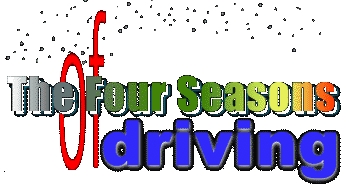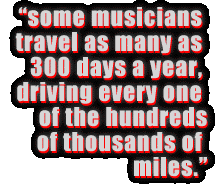|
In 1991, after thirteen years in bands, I left the road in part due to the grueling nature of the constant travel. Today, working a day-gig and playing part-time, I occasionally travel within the region. 
hen a child decides to play a musical instrument, driving is the farthest thing from their mind. When after years of practice, the grown child makes the parent-chilling decision to turn pro, driving still is a non-consideration. They are enchanted with music, wanderlust and of course, the "romance of the road." Yet, if there is one thing most professional musicians have in common, something decidedly non-musical to which is dedicated enormous amounts of time and energy, it is without question, driving. Entertainers have always had to travel, admittedly Of course, some musicians make their living without traveling and some have never traveled. Maybe they never saw the romance, or figured out early that all the driving was too much damn work just to play a gig. But this is a rare bird. Most professional musicians have spent time on the road, and possess a full appreciation of the difficulties, both mental and physical, of the driving life. This group; the great unwashed class of road dogs (of which I am a coffee-swilling, carseat-butt-tatooed member), have spent, or do spend inordinate amounts of time careening up and down interstate highways in cars, buses or vans, circulating endlessley within a region, or circling the country in a grand 48-state loop. The result is reams of stories, images and emotions inextricably linked by this common, mundane labor. When I typed all my driving morsels onto a page, the first pass yielded more than two dozen. As I considered them, loose categories emerged. There were four distinct moods, which I began to think of as the four "seasons" of driving: What follows are a few examples from each of the "seasons." It's a subjective trip; there's no set itinerary. Read them in order or randomly. Read a little or a lot; pull over if you get tired. Just wear your seatbelt and please, no smoking in the van...
NEXT ... |
|

 under greater duress than today. Eight hours in a 20-year-old
van is still pretty cushy compared to four weeks in a stagecoach, or
two months on a tramp steamer, but that doesn't make it a joy ride
either. I know musicians who travel as many as 300 days a year,
driving every one of the hundreds of thousands of miles. It's
grueling, manual labor.
under greater duress than today. Eight hours in a 20-year-old
van is still pretty cushy compared to four weeks in a stagecoach, or
two months on a tramp steamer, but that doesn't make it a joy ride
either. I know musicians who travel as many as 300 days a year,
driving every one of the hundreds of thousands of miles. It's
grueling, manual labor.